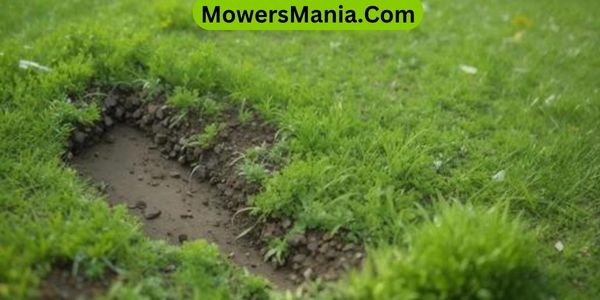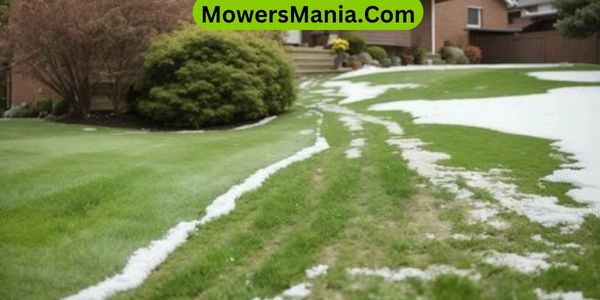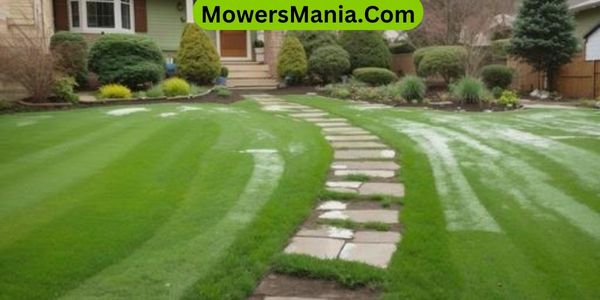Are you ready to revive your lawn after a harsh winter? Say goodbye to the brown patches and hello to a vibrant, green lawn.
In this article, we’ll show you the steps to take for a successful spring lawn renovation. From assessing the winter damage to repairing bare patches, we’ve got you covered.

Get ready to roll up your sleeves and transform your lawn into a lush paradise.
Assessing Winter Damage
Now that winter is over, it’s time for you to assess the damage it may have caused to your lawn. The harsh winter weather can take a toll on your once lush and green lawn, leaving it in need of some tender loving care.
Take a walk around your yard and carefully inspect the grass, looking for any signs of damage. Look out for areas where the grass has thinned out or turned brown, as these could be indicators of winter damage.
Also, keep an eye out for any signs of disease or pest infestation that may have occurred during the colder months.
During your assessment, make note of any areas that need attention. Is there any grass that needs to be reseeded or replaced?
Are there any bare patches that need to be filled in? It’s important to address these issues early on to ensure that your lawn can thrive in the upcoming spring and summer months.
In addition to assessing the grass, take a look at your lawn’s overall health. Are there any signs of compaction or soil erosion?
These issues can prevent your grass from receiving the necessary nutrients and water it needs to grow. Consider aerating and topdressing your lawn to improve its overall health and make it more resilient to future damage.
Raking and Removing Debris
To begin preparing your lawn for spring, start by raking and removing any debris that may have accumulated during the winter months. Winter can leave your lawn covered in fallen leaves, branches, and other debris that can hinder the growth and health of your grass.
By taking the time to remove this debris, you’re providing your lawn with a clean and fresh start for the upcoming season.
Raking is an essential step in the lawn renovation process as it helps to remove dead grass, thatch, and other organic matter that may have accumulated.
It also helps to loosen up the soil and allows for better air and water penetration. By removing debris and raking, you’re creating an optimal environment for new grass growth.
When raking, be sure to use a rake appropriate for your lawn size and condition. Start by raking in one direction, gradually working your way across the entire lawn. Be thorough in your raking, ensuring you remove all debris, including any hidden under the surface.
Once you have finished raking, gather and dispose of the debris properly. You can use a tarp or a bag to collect the debris and then dispose of it in accordance with your local waste management guidelines. If the debris is organic, consider composting it to create nutrient-rich soil for your garden.
Aeration and Overseeding

Now let’s talk about the benefits of aeration and the techniques for overseeding. Aeration helps to improve soil compaction, allowing nutrients and water to reach the roots more effectively.
Overseeding, on the other hand, helps to fill in bare spots and promote a thicker, healthier lawn.
Benefits of Aeration
Improve the health and appearance of your lawn by incorporating aeration into your spring lawn renovation routine.
Aeration is a process that involves creating small holes in the soil to allow air, water, and nutrients to penetrate the root zone of the grass.
This can have several benefits for your lawn, including:
- Enhanced root development: Aeration helps to break up compacted soil, allowing the roots to penetrate deeper and absorb more water and nutrients.
- Improved oxygen circulation: By creating channels in the soil, aeration promotes better air circulation, which is essential for the roots’ respiration and overall plant health.
- Increased nutrient uptake: Aeration allows fertilizers and other nutrients to reach the roots more effectively, resulting in improved nutrient absorption and healthier grass.
Overseeding Techniques
Once you have completed the aeration process, it’s time to move on to the next step: overseeding your lawn.
Overseeding is an important technique for repairing winter damage and promoting a green, healthy lawn. To overseed your lawn, start by choosing the right grass seed for your region and lawn conditions.
Next, prepare the soil by raking away any debris and loosening the top layer. This will create a good seed-to-soil contact for optimal germination. Then, evenly spread the grass seed over your lawn using a spreader or by hand. Make sure to follow the recommended seeding rate for your specific grass type.
After seeding, lightly rake the area to incorporate the seeds into the soil. Finally, water the newly seeded area regularly to keep it moist until the grass germinates and establishes itself.
Repairing Bare Patches
Now let’s talk about how to repair those bare patches in your lawn.
There are two main options you can consider: seeding or sodding. Seeding involves spreading grass seed over the bare areas and allowing it to grow.
Sodding, on the other hand, involves laying down strips of pre-grown grass. Additionally, it’s important to address any erosion issues that may have contributed to the bare patches.
This can be done by implementing erosion control methods such as installing retaining walls or using erosion control blankets.
Seeding Vs. Sodding
To repair bare patches in your lawn, consider using one of two methods: seeding or sodding.
Seeding involves spreading grass seeds over the bare areas and allowing them to germinate and grow. It’s a cost-effective option that allows for a variety of grass types to be chosen based on your preferences and the conditions of your lawn.
Sodding, on the other hand, involves laying down pre-grown grass squares or rolls directly onto the bare patches. This method provides instant results and a uniform appearance. However, it can be more expensive and limited in grass variety options.
Ultimately, the choice between seeding and sodding depends on your budget, time constraints, and personal preferences.
Erosion Control Methods
If you opted for seeding to repair bare patches in your lawn, you can effectively control erosion by implementing a few proven methods.
One method is to use erosion control blankets or mats. These are made of biodegradable materials and help to stabilize the soil and prevent erosion. Simply place the blanket over the seeded area and secure it with landscape staples.
Another method is to create terraces or steps on slopes. This involves creating level areas with retaining walls or steps, which helps to slow down the flow of water and prevent erosion.
Additionally, you can use straw or mulch to cover the seeded areas. This provides a protective layer that helps retain moisture and prevent erosion.
Implementing these erosion control methods will help repair bare patches and ensure a healthy, green lawn.
Soil Testing and Fertilizing
Start by conducting a soil test to determine the nutrient levels and pH of your lawn. This will provide valuable information on the condition of your soil and help you make informed decisions about fertilizing.
A soil test will reveal if your soil is lacking in any essential nutrients, such as nitrogen, phosphorus, or potassium. It will also indicate the pH level, which is crucial for nutrient availability to the grass.
Once you have the results of the soil test, you can then proceed with fertilizing your lawn.
Here are three important factors to consider when fertilizing:
- Choose the right fertilizer: Based on the nutrient deficiencies identified in the soil test, select a fertilizer that contains the appropriate ratio of nitrogen, phosphorus, and potassium. Look for a slow-release fertilizer that will provide a steady supply of nutrients over time.
- Follow the recommended application rates: Over-fertilizing can harm your lawn and lead to excessive growth, which can make it more susceptible to disease and pests. Apply the fertilizer according to the recommended rates to avoid these issues.
- Timing is key: Apply the fertilizer at the right time to maximize its effectiveness. Generally, it’s best to fertilize in early spring, when the grass is actively growing and can benefit the most from the nutrients.
Watering and Irrigation Tips
Maintain a consistent watering schedule throughout the spring to ensure your lawn receives the proper amount of moisture.
Adequate watering is crucial for the health and growth of your grass. Watering deeply and infrequently is the key to encouraging deep root growth, which makes your lawn more resilient to drought conditions.
It’s recommended to water your lawn in the early morning, as this allows the grass blades to dry before evening, reducing the risk of disease.
Avoid watering in the afternoon when the heat is at its peak, as much of the water will evaporate before it can be absorbed by the soil.
When watering, aim for about 1 inch of water per week, including rainfall. Use a rain gauge or an empty tuna can to measure the amount of water your lawn is receiving.
If you have an automatic sprinkler system, adjust the settings accordingly to ensure even coverage. Additionally, consider using a soaker hose or drip irrigation system to minimize water waste.
Maintaining and Preventing Future Damage

To ensure the long-term health and appearance of your lawn, it’s essential to implement proper maintenance practices and take steps to prevent future damage.
Here are three key actions you can take:
- Regular mowing: Keep your grass at the recommended height for your specific type of grass. Cutting it too short can weaken the roots and make your lawn more susceptible to damage. Aim to mow your lawn regularly, removing no more than one-third of the grass blade at a time.
- Fertilizing: Providing your lawn with the right nutrients is crucial for its overall health and resilience. Apply a balanced fertilizer in the spring and fall, following the instructions on the packaging. This will help promote healthy growth, strong roots, and vibrant green color.
- Weed control: Weeds not only detract from the appearance of your lawn but also compete with your grass for nutrients and water. Regularly inspect your lawn for weeds and promptly remove them by hand or use an appropriate herbicide. This will help prevent them from spreading and taking over your lawn.
Frequently Asked Questions [FAQs]
How Long Does It Typically Take for Grass to Recover From Winter Damage?
“It typically takes a few weeks for grass to recover from winter damage. With proper care, including regular watering and fertilizing, you can help your lawn regain its green and healthy appearance.”
Can I Use a Leaf Blower Instead of Raking to Remove Debris From My Lawn?
You can use a leaf blower instead of raking to remove debris from your lawn. It’s a quicker option but make sure the blower is set on a low setting to avoid damaging the grass.
Is It Necessary to Aerate and Overseed My Lawn Every Year?
Is it necessary to aerate and overseed your lawn every year? It depends on the condition of your lawn and your desired results. Regular aeration and overseeding can help promote healthy growth and fill in bare patches.
What Are Some Natural Remedies for Repairing Bare Patches in the Lawn?
For repairing bare patches in your lawn, consider natural remedies like spreading compost or topsoil, overseeding with grass seed, and watering consistently. These methods can help restore the greenness of your lawn.
How Often Should I Conduct Soil Testing and Fertilizing to Maintain a Healthy Lawn?
You should conduct soil testing and fertilizing regularly to maintain a healthy lawn. It’s important to know the nutrient levels in your soil and provide the necessary fertilizers to keep your grass green and thriving.
Conclusion
In conclusion, by following these spring lawn renovation steps, you can repair winter damage and achieve a vibrant, green lawn. Assess the damage, remove debris, aerate and overseed, and repair bare patches.
Don’t forget to conduct a soil test and fertilize accordingly. Proper watering and irrigation practices will also help maintain your lawn’s health.
With regular maintenance and prevention measures, you can ensure a beautiful lawn throughout the year.
So go ahead and give your lawn the love and care it deserves!



